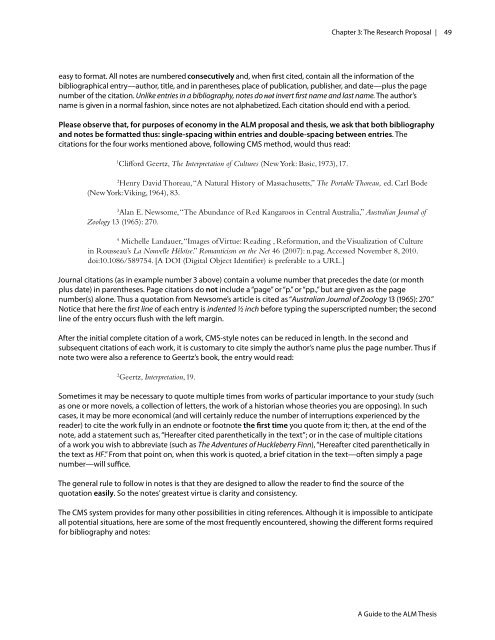A Guide to the ALM Thesis - iSites - Harvard University
A Guide to the ALM Thesis - iSites - Harvard University
A Guide to the ALM Thesis - iSites - Harvard University
Create successful ePaper yourself
Turn your PDF publications into a flip-book with our unique Google optimized e-Paper software.
Chapter 3: The Research Proposal | 49<br />
easy <strong>to</strong> format. All notes are numbered consecutively and, when first cited, contain all <strong>the</strong> information of <strong>the</strong><br />
bibliographical entry—author, title, and in paren<strong>the</strong>ses, place of publication, publisher, and date—plus <strong>the</strong> page<br />
number of <strong>the</strong> citation. Unlike entries in a bibliography, notes do not invert first name and last name. The author’s<br />
name is given in a normal fashion, since notes are not alphabetized. Each citation should end with a period.<br />
Please observe that, for purposes of economy in <strong>the</strong> <strong>ALM</strong> proposal and <strong>the</strong>sis, we ask that both bibliography<br />
and notes be formatted thus: single-spacing within entries and double-spacing between entries. The<br />
citations for <strong>the</strong> four works mentioned above, following CMS method, would thus read:<br />
1<br />
Clifford Geertz, The Interpretation of Cultures (New York: Basic, 1973), 17.<br />
2<br />
Henry David Thoreau, “A Natural His<strong>to</strong>ry of Massachusetts,” The Portable Thoreau, ed. Carl Bode<br />
(New York: Viking, 1964), 83.<br />
3<br />
Alan E. Newsome, “The Abundance of Red Kangaroos in Central Australia,” Australian Journal of<br />
Zoology 13 (1965): 270.<br />
4<br />
Michelle Landauer, “Images of Virtue: Reading , Reformation, and <strong>the</strong> Visualization of Culture<br />
in Rousseau’s La Nouvelle Héloïse.” Romanticism on <strong>the</strong> Net 46 (2007): n.pag. Accessed November 8, 2010.<br />
doi:10.1086/589754. [A DOI (Digital Object Identifier) is preferable <strong>to</strong> a URL.]<br />
Journal citations (as in example number 3 above) contain a volume number that precedes <strong>the</strong> date (or month<br />
plus date) in paren<strong>the</strong>ses. Page citations do not include a “page” or “p.” or “pp.,” but are given as <strong>the</strong> page<br />
number(s) alone. Thus a quotation from Newsome’s article is cited as “Australian Journal of Zoology 13 (1965): 270.”<br />
Notice that here <strong>the</strong> first line of each entry is indented ½ inch before typing <strong>the</strong> superscripted number; <strong>the</strong> second<br />
line of <strong>the</strong> entry occurs flush with <strong>the</strong> left margin.<br />
After <strong>the</strong> initial complete citation of a work, CMS-style notes can be reduced in length. In <strong>the</strong> second and<br />
subsequent citations of each work, it is cus<strong>to</strong>mary <strong>to</strong> cite simply <strong>the</strong> author’s name plus <strong>the</strong> page number. Thus if<br />
note two were also a reference <strong>to</strong> Geertz’s book, <strong>the</strong> entry would read:<br />
2<br />
Geertz, Interpretation, 19.<br />
Sometimes it may be necessary <strong>to</strong> quote multiple times from works of particular importance <strong>to</strong> your study (such<br />
as one or more novels, a collection of letters, <strong>the</strong> work of a his<strong>to</strong>rian whose <strong>the</strong>ories you are opposing). In such<br />
cases, it may be more economical (and will certainly reduce <strong>the</strong> number of interruptions experienced by <strong>the</strong><br />
reader) <strong>to</strong> cite <strong>the</strong> work fully in an endnote or footnote <strong>the</strong> first time you quote from it; <strong>the</strong>n, at <strong>the</strong> end of <strong>the</strong><br />
note, add a statement such as, “Hereafter cited paren<strong>the</strong>tically in <strong>the</strong> text”; or in <strong>the</strong> case of multiple citations<br />
of a work you wish <strong>to</strong> abbreviate (such as The Adventures of Huckleberry Finn), “Hereafter cited paren<strong>the</strong>tically in<br />
<strong>the</strong> text as HF.” From that point on, when this work is quoted, a brief citation in <strong>the</strong> text—often simply a page<br />
number—will suffice.<br />
The general rule <strong>to</strong> follow in notes is that <strong>the</strong>y are designed <strong>to</strong> allow <strong>the</strong> reader <strong>to</strong> find <strong>the</strong> source of <strong>the</strong><br />
quotation easily. So <strong>the</strong> notes’ greatest virtue is clarity and consistency.<br />
The CMS system provides for many o<strong>the</strong>r possibilities in citing references. Although it is impossible <strong>to</strong> anticipate<br />
all potential situations, here are some of <strong>the</strong> most frequently encountered, showing <strong>the</strong> different forms required<br />
for bibliography and notes:<br />
A <strong>Guide</strong> <strong>to</strong> <strong>the</strong> <strong>ALM</strong> <strong>Thesis</strong>

















